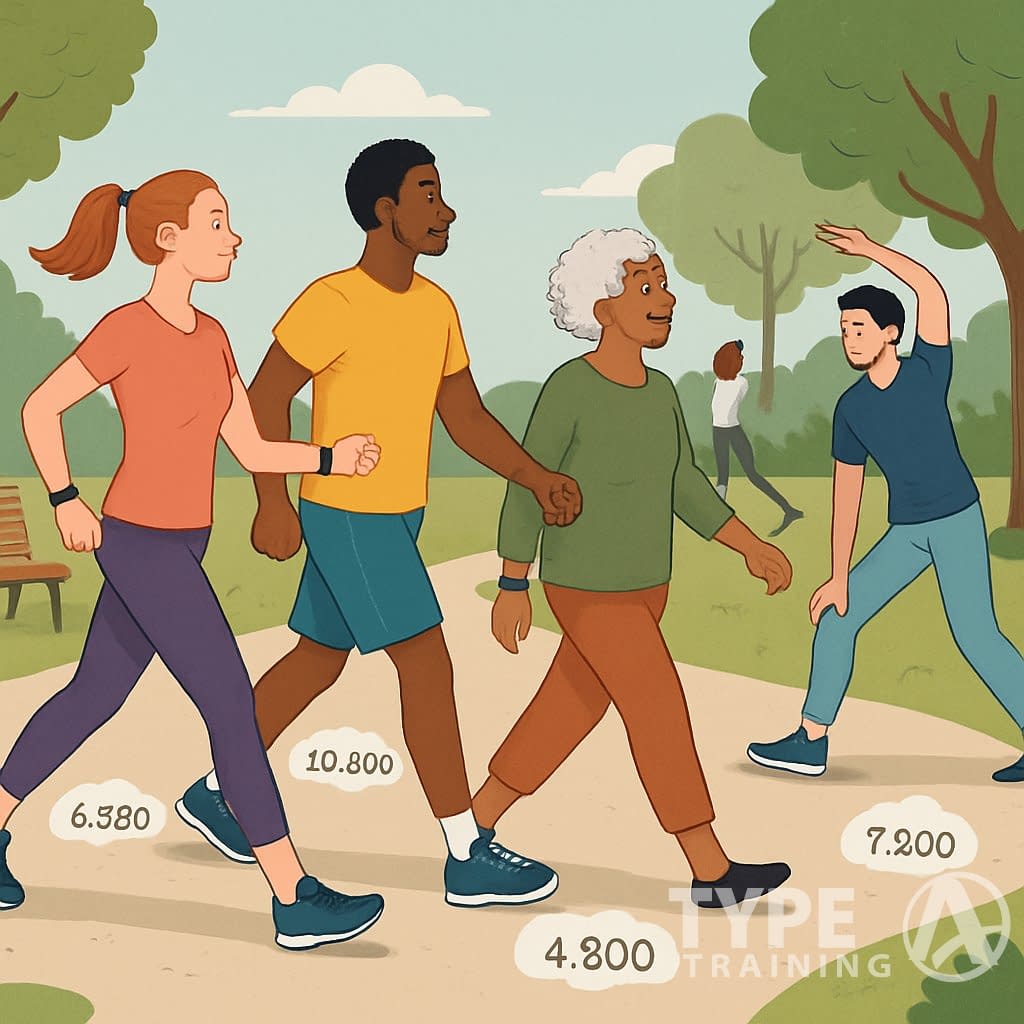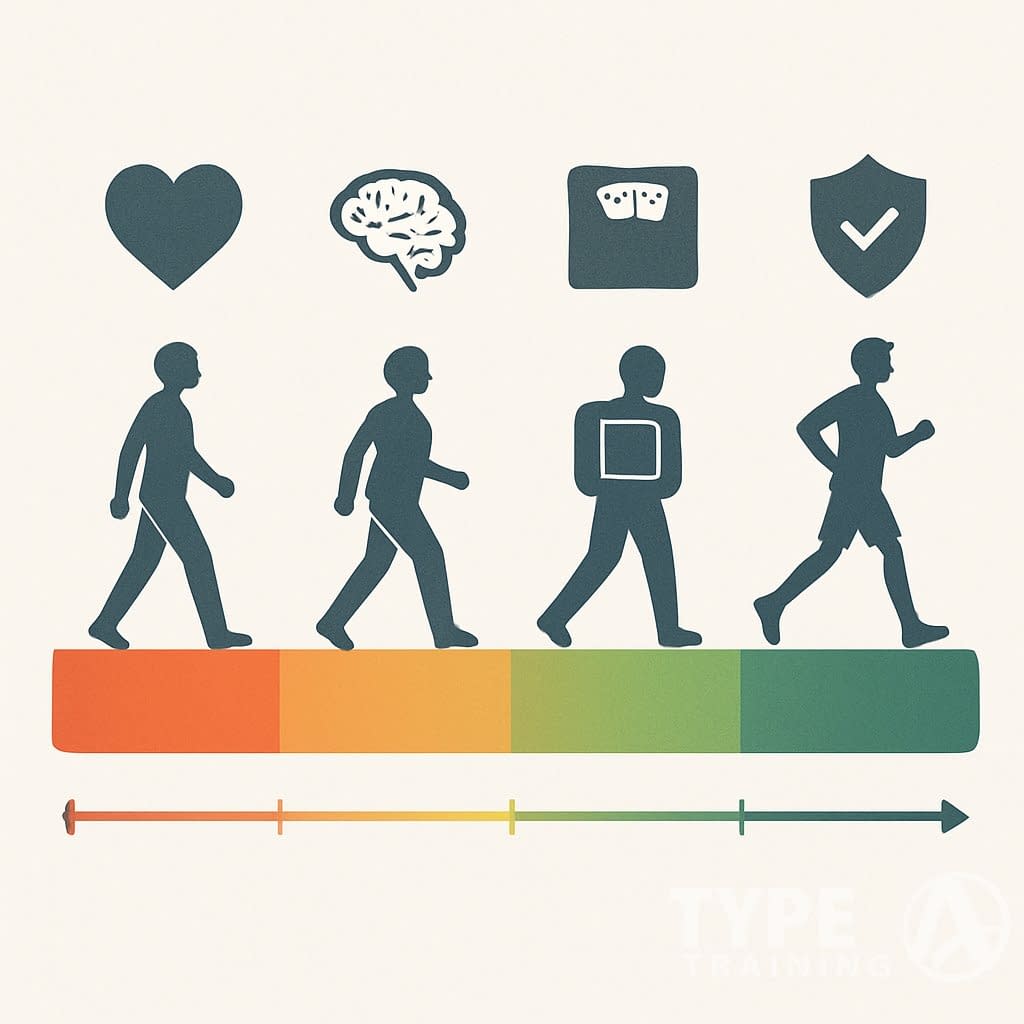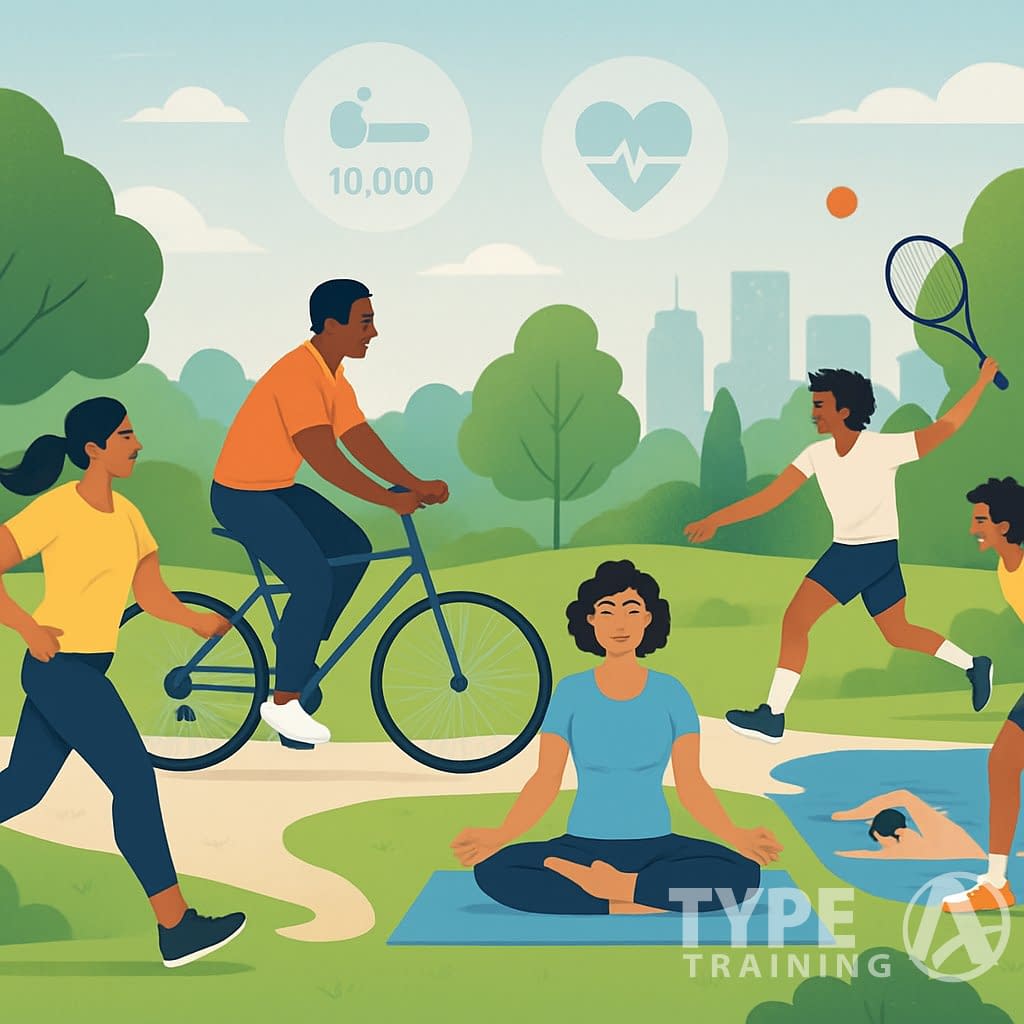Most of us have heard that walking 10,000 steps a day is the magic number for good health. But where did that number even come from? This is part of the 10000 steps myth that many believe. Understanding the 10000 steps myth is crucial for setting realistic fitness goals.
Turns out, the 10000-step benchmark didn’t come from scientists crunching numbers. It actually started as a marketing campaign for a Japanese pedometer called “Manpo-kei,” which just means “10000 step meter.”

Recent research shows you can get real health benefits from as few as 2,500 to 2,700 steps a day. The strongest protection against cardiovascular disease seems to kick in around 7,000 daily steps.
Popular posts:
This notion of the 10000 steps myth is widespread, yet new research shows you can get real health benefits from as few as 2,500 to 2,700 steps a day.
If you’re under 60, aiming for 8,000 to 10,000 steps is linked to the best life expectancy and heart health. For folks over 60, you might see the most benefit at lower step counts.
If you’re not close to 10,000 steps, don’t stress. Try adding just 1,000 extra steps every couple weeks to your routine.
This kind of slow, steady increase makes a sustainable walking habit much easier to stick with.
Origins of the 10,000 Steps Recommendation

The 10,000 steps goal didn’t come from any big scientific breakthrough. It started as a marketing idea in Japan, contributing to the ongoing conversation around the 10000 steps myth that influences many people’s fitness journeys.
This has contributed to the ongoing discussion around the 10000 steps myth and its impact on fitness standards that can mislead individuals.
This widespread notion reinforces the 10000 steps myth, as many people still strive for this arbitrary target without understanding its origins.
That arbitrary number has influenced fitness standards everywhere, including the prevailing misconceptions tied to the 10000 steps myth, even though it didn’t have much scientific backing at first.
History of the Manpo-kei and Japanese Walking Clubs
Back in the 1960s, a Japanese pedometer called manpo-kei was invented. The name literally means “10,000 steps meter.”
This gadget popped up during a fitness boom after the 1964 Tokyo Olympics. Health consciousness was on the rise in Japan.
Japanese walking clubs started using the manpo-kei as their go-to tool. These clubs gave people social support and motivation to walk more.
The number 10000 wasn’t chosen for health reasons. In Japanese culture, 10,000 (万, “man”) stands for completeness or abundance.
This is why it’s essential to debunk the 10000 steps myth and focus on personal health and fitness goals based on individual needs.
Plus, it’s just a nice, round, memorable number.
10,000 Steps as a Marketing Strategy
The Yamasa Clock company (which later became Yamasa Tokei) developed the manpo-kei. Yoshiro Hatano, the company’s president, saw a business opportunity in Japan’s growing health craze.
Their marketing was brilliantly simple: set 10,000 as the “magic number” for daily steps, then sell a device that counts them.
People loved the idea. The pedometer took off, and the 10,000 steps goal became part of Japanese fitness culture—without any actual scientific proof.
Global Adoption of the 10,000 Steps Goal
Over time, the 10,000 steps idea spread worldwide. Western health researchers started using the 10,000 steps metric in their studies because it was already a popular benchmark.
Fitness tech companies jumped on board, too. They built 10,000 steps into activity trackers and smartphone apps as the default goal.
Governments and workplace wellness programs picked it up. The number sounded good—challenging, but doable—and it was easy to promote, even though it wasn’t really backed by science.
Scientific Evidence: How Many Steps for Health Benefits?
We don’t actually need 10,000 steps a day to get real health benefits. The right number depends on your age and what you’re hoping to achieve.
Key Findings from Recent Meta-Analyses
Recent studies have poked holes in the 10,000 steps myth. For adults under 60, walking between 8,000 and 10,000 steps daily gives you the best shot at living longer and keeping your heart healthy.
If you’re over 60, you don’t have to go as far to see big benefits. That’s a relief for anyone who finds 10,000 steps intimidating.
Researchers now say health benefits start at just 2,500 to 2,700 steps a day. For most adults, the mortality benefits seem to level off around 7,500 steps.
That means pushing yourself from 7,500 to 10,000 steps probably won’t add much in terms of living longer.
Comparing 2,500, 9,000, and 10,000 Steps
The jump from 2,500 steps to 7,000 steps brings real improvements. Even at 2,500 steps, you’re doing better than if you’re barely moving at all.
At around 7,000 steps, you hit a sweet spot for preventing heart disease. That’s a lot less than 10,000, which many people struggle to reach.
Between 8,000 and 9,000 steps, benefits start to plateau. There’s not much extra magic in going all the way to 10,000.
Physical Activity Guidelines Versus Step Goals
Traditional exercise guidelines recommend 150 minutes of moderate activity a week. That’s about 5,000 to 6,000 steps a day.
Here’s how it breaks down:
- 5,000–6,000 steps ≈ 150 minutes moderate activity/week
- 7,500 steps = Where mortality benefits peak
- 10,000 steps = Not needed for most people
Think about your age, fitness level, and goals when you set your step target. For most, 7,000–8,000 steps is a realistic, science-backed goal that still gives you plenty of health perks.
What really matters is sticking with it. Walking steadily at a moderate pace most days beats occasional big step days.
Health Outcomes Associated With Different Step Counts
Different step counts bring different health benefits. Researchers have found some clear thresholds where things start to improve, and some key milestones where the benefits really ramp up.
Impact on Cardiovascular Disease and Heart Failure
Adding more steps each day helps your heart—no question. Even 2,500–2,700 steps daily can start to make a difference, but the strongest protection against cardiovascular disease shows up at about 7,000 steps.
For adults under 60, 8,000–10,000 steps daily seems to bring the most heart benefits. Older adults can get solid improvements with fewer steps.
Regular walking lowers
If you move from being sedentary (under 4,000 steps) to moderately active, you could see up to a 40% drop in cardiovascular event risk—even without ever hitting 10,000 steps.
Effects on Diabetes, Cancer, and Chronic Disease
Daily walking at a moderate level helps regulate blood sugar. People who get 7,000–8,000 steps a day show better insulin sensitivity.
Walking also helps with cancer prevention. Studies say that 5,000 steps or more per day is linked to lower risks of some cancers, like colon and breast cancer.
There’s a dose-response effect:
- 2,000–4,000 steps: Some benefit
- 5,000–7,000 steps: Moderate benefit
- 7,000+ steps: Substantial benefit
Consistency wins out over intensity here. Walking more steps at a comfortable pace usually gives better results than fewer, tougher steps.
Step Counts and Risk Reduction in Stroke
More daily steps mean less stroke risk. Research shows that 7,000 steps a day can significantly lower stroke risk by improving circulation and reducing
Here’s what researchers have found:
- Below 4,000 steps: Not much protection
- 4,000–7,000 steps: Some protection
- Above 7,000 steps: Best protection
Walking helps by making blood vessels more flexible, reducing inflammation, and keeping weight and stress in check.
Even if you already have risk factors, adding just 2,000 steps a day can cut your stroke risk by about 10%. Most adults see the protective effect level off around 9,000–10,000 steps.
Influence on Life Expectancy and Longevity
Taking more steps each day links directly to living longer. The NIH says you can get health benefits with fewer than 10,000 steps.
For people over 60, the biggest longevity boost happens between 6,000 and 8,000 steps per day. You don’t need to hit 10,000 to see gains.
The benefits start to taper off after certain points. Every extra 1,000 steps up to about 8,000 brings real life expectancy perks, but after that, the gains are smaller.
How fast you walk doesn’t matter as much as how far you go. Step count matters more than step intensity, so walking is accessible for almost everyone, regardless of fitness level.
Step Counting Devices and Monitoring Progress
Technology has completely changed how we keep tabs on our daily movement. It’s now much easier to track steps and notice patterns in how we move.
Devices on the market come with a range of features. Some focus on simplicity, while others pack in all sorts of extras for folks who want more insight.
Pedometers Versus Fitness Trackers
Basic pedometers use a pendulum mechanism to count steps by picking up hip movement. They’re cheap, straightforward, and do just the one job—step counting.
Most basic pedometers cost less than $20. You can set them up in minutes and forget about them.
Fitness trackers, on the other hand, go way beyond simple step-counting devices. They track heart rate, calories burned, sleep, and can even figure out if you’re running or cycling.
Popular fitness trackers sync with smartphone apps. You get to see trends over weeks or months, which can help you spot habits and tweak your routine.
If you just want to count steps, a pedometer is probably all you need. If you want more data and comprehensive health monitoring, a fitness tracker is the way to go.
Accuracy and Limitations of Step Counters
No step counter nails it 100% of the time. Most have an error margin of about 10-15%—that’s just the reality.
Wrist-worn trackers sometimes mistake arm swings for steps. Phone-based counters won’t count anything if you leave your phone on the table.
How you walk matters, too. Step counter accuracy is usually better when you’re walking briskly, not shuffling along.
Most devices struggle with activities like swimming, cycling, or lifting weights. These are healthy, but your step count won’t reflect them.
Try wearing your tracker on your non-dominant hand for better results. Clip-on pedometers work best when you place them right above your hip.
If you calibrate your device using your actual stride length, you can boost accuracy a bit.
Role of Step-Counting Devices in Health Consciousness
Step counters do more than just tally numbers. They make you notice how much (or how little) you move.
A lot of people feel the “reminder effect”—seeing a low step count nudges them to take a quick walk. That heightened health awareness often spreads to other habits, too.
Social features in many trackers add a sense of accountability. Competing with friends or coworkers can make reaching your goals more fun.
Graphs and charts help you spot trends and set goals that actually fit your life. Having real data makes it easier to turn vague intentions into something you can actually achieve.
Beyond Steps: The Broader Picture of Physical Activity
Counting steps is handy, but real health benefits come from the quality of your movement and an active lifestyle.
Brisk Walking and Exercise Intensity
Not every step is equal. Walking briskly (about 100 steps per minute) gives you better cardiovascular benefits than just ambling around.
If you can talk but not sing during your walk, you’re probably in the moderate-intensity zone. Experts recommend at least 150 minutes of moderate-intensity activity each week.
A 20-minute brisk walk can do more for your health than 40 minutes of slow strolling. Try adding intervals of faster walking to get more out of the same amount of time.
Daily Movement Versus Sedentary Behavior
Breaking up long stretches of sitting might matter just as much as your total steps. Even if you hit your step goal, sitting all day isn’t great.
Stand up or move around for a couple of minutes every half hour if you can. Simple things like housework, gardening, or taking the stairs all count.
Staying active throughout the day leads to better outcomes than cramming all your movement into one exercise session. The hours you spend not sitting might be just as important as formal workouts.
Maybe try tracking your non-sedentary hours along with your steps for a fuller picture.
Personalizing Your Daily Step Count
Your ideal step count isn’t necessarily 10,000. It really depends on your own health, age, and fitness level.
Adapting Goals Based on Fitness Level and Age
Your step goal should fit your current fitness level and age. If you’re new to this, start by tracking your steps for a week to see where you stand.
Most people under 60 benefit most from 8,000-10,000 steps a day. If you’re over 60, you might see real improvements with fewer steps.
Some studies show health benefits start as low as 2,500-2,700 steps. Significant heart protection kicks in around 7,000 steps. That’s encouraging if 10,000 feels out of reach.
Setting Realistic Health Goals
Don’t get hung up on 10,000 steps. Try adding 1,000 steps every couple of weeks instead.
Match your goals to what you want to achieve:
- Weight loss: Go for 7,000-10,000 steps
- Mood boost: Even 4,000-6,000 steps can help
- Better sleep: Walk regularly throughout the day
- Lower
blood pressure : Aim for 5,000+ steps
Round numbers aren’t magic. Don’t beat yourself up if you fall short—increasing from 5,000 to 9,000 steps still makes a big difference.
Integrating Steps Into Your Daily Routine
You don’t need to overhaul your life to walk more. Small tweaks can add a surprising number of steps.
Morning:
- Take a quick walk before breakfast
- Park farther away
- Get off the bus or train a stop early
At work:
- Try walking meetings
- Set reminders to stand and move every hour
- Use stairs, not elevators
- Visit coworkers in person
Evening:
- Walk after dinner
- Do chores that keep you moving
- Maybe use a treadmill desk while watching TV
Track your steps, but don’t obsess over perfection. Even short walking breaks add up, especially on busy days.
Broader Health Benefits of Walking More
Walking does a lot more than just move the step counter. It helps with weight, mood, focus—honestly, the list goes on.
Weight Loss and Energy Expenditure
Walking can really help with weight management. A brisk 30-minute walk usually burns 100-300 calories, depending on your size and pace.
Do that regularly and it adds up over time. Plus, your body keeps burning calories for a bit after you finish walking—the so-called “afterburn effect.”
Regular walking builds muscle in your legs and core. More muscle means you burn more calories, even when you’re just sitting around.
Walking is also gentle on your joints. If high-impact workouts aren’t your thing, walking is a solid choice.
Quality of Life and Well-Being
People who walk daily often sleep better. They tend to fall asleep faster and enjoy deeper rest.
Getting outside for a walk exposes you to natural light, which can help regulate your internal clock and boost your energy.
Walking also gives your immune system a lift. Moderate, regular activity increases the circulation of immune cells.
It can lower
Mental and Cognitive Function
Walking cuts the risk of dementia by up to 50% if you stick with it. The increased blood flow supports brain health and helps new neural connections form.
A lot of people find their best ideas come while walking. It’s great for creative thinking.
Walking releases endorphins and lowers stress hormones like cortisol. Even a 10-minute stroll can lift your mood when you’re feeling down.
Getting out in nature makes these effects even stronger. “Green exercise” seems to reduce negative thoughts better than indoor workouts.
Frequently Asked Questions
Step counts raise a lot of questions. Here are some quick answers to the most common ones.
What is the origin of the 10,000 steps a day concept?
The famous 10,000-step goal didn’t come from scientists. It actually started as a marketing campaign in Japan in the 1960s.
A company released a pedometer called “Manpo-kei,” which means “10,000 steps meter.” The number was catchy and easy to remember, so it stuck.
How many steps per day are recommended for different age groups?
If you’re under 60, 8,000 to 10,000 steps a day is a solid target for longevity and heart health.
Older adults still get big benefits with fewer steps. Research shows you don’t need to hit 10,000 to see improvements.
What really matters is moving more than you do now. Any bump in your daily steps is a win.
What are the health implications of walking less than 10,000 steps a day?
Health benefits kick in at just 2,500 to 2,700 steps per day. That’s honestly pretty encouraging if you aren’t super active right now.
For cardiovascular disease prevention, 7,000 daily steps seems to be the sweet spot. Researchers have noticed that benefits start to level off after about 8,000 steps.
Even small boosts in daily activity can make a pretty big difference, especially if you’re starting from scratch.
Can walking 10,000 steps a day significantly contribute to weight loss?
Walking 10,000 steps helps with weight loss, but only if you pair it with healthy eating. Burning calories through walking can definitely move the needle, but it’s not magic on its own.
How many calories you burn really depends on your weight, pace, and even the terrain. It’s not a one-size-fits-all thing.
If you want to manage your weight, sticking to regular daily walks matters more than hitting some huge step goal once in a while.
How do various step counts translate into distances in kilometers or miles?
Your stride length changes how far your steps actually take you. For most adults, 2,000 steps is roughly a mile, or about 1.6 kilometers.
So, 10,000 steps would be about 5 miles, or 8 kilometers. Of course, your own numbers might be a bit different, depending on how tall you are and how you walk.
Most fitness trackers can convert your steps into miles using your stride length, which makes things a whole lot easier.
What have studies revealed about the actual number of steps needed for health benefits?
Turns out, you don’t need to hit 10,000 steps a day for your health to improve. Research finds that even 2,500 to 3,000 daily steps can make a difference in your health markers.
The Department of Health and Human Services recommends 150–300 minutes of moderate-intensity activity each week. That’s not the same as 10,000 steps a day, and honestly, it’s probably a relief for most of us.
Studies show health benefits rise quickly at lower step counts. Then, things start to level off and plateau around 8,000 steps.
So, maybe the bar isn’t as high as we once thought.













